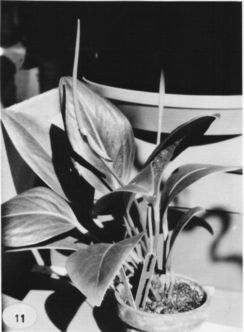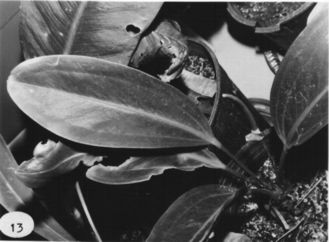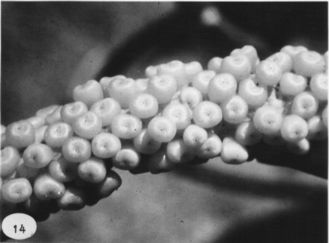





Anthurium bicollectivum Croat, sp. nov.
TYPE: Panama. Panama: middle slopes of Cerro Campana, ca. 1 mi. from Pan-American Hwy., ca. 150 m, Croat 35943 (MO 2388982, holotype; CAS, K, NY, PMA, US, isotypes; Live at MO).
Plants epiphytica; cataphyllum persistens reticulum fibrasum; petiolus (2-)9-17(-23) cm longus, subteres, late sulcatus, conspicue glanduloso-punctatus; lamina elliptica ad oblongo-elliptica, coriacea, apice abrupte brevi-acuminata, basi acuta ad obtusa, (5-)16-25(-30) cm longa, (3-)8-10(-13.5) cm lata, utrinque glandu-loso-punctata; inflorescentia erecta et effusa; pedun-culus teres, (9-)17-34(÷46) cm longus; spatha subcoriacea, viridis pallide, lanceolate ad oblongo-lanccolata, 4-9 cm longa, 1.5-2.5 cm lata; spadix luteo-viridis, (5-)9-20(-23) cm longus; baccae subglobosac, luteo-aurantiacae; semina 1-4.
Epiphyte; stems less than 20 cm long, 1-2 cm diam.; leaf scars and internodes hidden by cataphylls; roots moderately few, thin, green; cataphylls moderately thin, 4-6 cm long, rounded at apex (the acumen apiculate), drying brown, weathering to persistent, reticulate fibers.
LEAVES erect to spreading; petioles (2-)9-17(-23) cm long, 5-7 mm diam., subtcrcte, broadly and sharply sulcate, conspicuously dark glandular-punctate on surface; geniculum 1-3 cm long; blades elliptic to oblong-elliptic, coriaceous, abruptly short-acuminate at apex (the acumen downtumed, the blade sometimes conspicuously arching), acute to obtuse at base, (5-) 16-25(-30) cm long; (3-)8-10(-13.5) cm wide, broadest at middle or in lower half, usually revolute near the margins; upper surface matte to semiglossy, lower surface matte, both surfaces dark glandular-punctate; midrib convexly raised above, narrowing and sunken at apex, convexly raised below; primary lateral veins 7-10(-20) per side, departing midrib at 30-50° angle, scarcely raised above, shallowly sunken below; interprimary veins scarcely less prominent than primary lateral veins (drying equally conspicuous); basal veins 2 or 3, the first forming a collective vein 1-2 cm from the margin, the second extending to the apex 6 mm or less from the margin or merging with margin usually at middle or above, the third when present merging with margin in the lower one-fourth of blade.
INFLORESCENCE erect to spreading; peduncle (9-) 17-34(-46) cm long, 3-6 mm diam., terete; spathe moderately thick, pale green, lanceolate to oblong-lanceolate, 4÷9 cm long, 1.5-2.5 cm wide. broadest in the basal third, abruptly acuminate at apex, obtuse at base, obliquely attached and decurrent 0.5-1 cm on peduncle, inserted at 50-60° angle on peduncle, usually strongly reflexed. held parallel to peduncle; spadix yellow-green (B & K Yellow-green 7/7.5), tapered toward apex. (5-)9-20(-23) cm long, 5-7 mm diam. at base, 3-4 mm diam. at apex; flowers rhombic, 3-5 mm long, 2.7-4 mm wide, the sides sigmoid, 5-6 flowers visible in the principal spiral, 7-8 visible in the alternate spiral; tepals matte, lateral tepals 1-1.5 mm wide, the inner margins straight to concave; pistils weakly raised, darker green than tepals; stigmas weakly exserted, with minute droplet for ca. 1 week; stamens emerging in a regular sequence beginning at base, laterals first, followed by alternates, laterals completely retracting as alternates emerge, usually 2 (rarely 3) visible at any time, ultimately retracted throughout; anthers flat, 0.3-0.6 mm long, 0.7-0.11 mm wide; thecae more or less translucent; pollen scarce, pale yellow, fading to white.
INFRUCTESCENCE spreading to pendent; berries subglobose, yellow-orange (B & K Yellow-red 8/7.5), rounded to truncate at apex; mesocarp gelatinous with numerous, minute raphide cells; seeds 1÷4, greenish white, 2.1-2.6 mm long, 1.5-1.9 mm wide, 1-1.3 mm thick, the appendages slender, attached at both ends. Figs. 11, 13, and 14.
Anthurium bicollectivum is endemic to Panama but is to be expected in northern Colombia in the Department of Choco. It ranges from 200 to 1,000 m and occurs in premontane wet, tropical wet, and premontane rain forest. It is known principally from central Panama in Veraguas, Col—n, Code, and Panama Provinces with an outlying collection in the Central Cordillera in Darien Province, but it is unknown from the Serrania de Darien.
The species, a member of section Porphyrochitonium, is perhaps the most variable species of this section. Blade shape varies from lanceolate with acute apices to broadly obovate or elliptic with rounded, minutely cuspidate apices. Also variable is the disposition of the inflorescence (sometimes with a stiffly erect peduncle or sometimes with the peduncle more slender and flexible).
The species is distinguished by the presence of two pairs of collective veins (thus the name bicollectivum) along each margin. The second collective vein (antemarginal collective) usually extends all the way to the apex and a third pair is sometimes present, usually joining the margin in the lower fourth of the blade. Other distinguishing features include coriaceous, glandular-punctate leaves with petioles usually much shorter than the blades, green or yellow-green spadix, green spathe (turning yellow to orange in age), and yellow-orange to orange berries.
 |
 |
 |
Map of Mesoamerican specimens with coordinates
Costa Rica Alajuela: R.B. Monteverde; Cordillera de Tilarán,
820 m, 10.19N 84.43W, 2 October 1990, Erick Bello 2433 (CR, MO).
Costa Rica Alajuela: R.B. Monteverde; Cordillera de Tilarán,
820 m, 10.19N 84.43W, 24 June 1991, Erick Bello & Eladio Cruz 2792
(CR, MO).
Costa Rica Lim—n: 1250 m, 09.24.00N 83.05.40W, 15 Mar 1992, Herrera,
G. 5347 (INB, CR).
Panama Chiriquí: 1200-1400 m, 8.50N 82.43W, 11 July 1983, C. Hamilton
& K. Krager 3790 (MO).
Panama CoclŽ: La Mesa Region, 2400 ft.,, 2 July 1978, Hammel 3901 (SEL).
Panama Panamá: 840-900 m, 08.41N 79.56W, 19 July 1990, M. H. Grayum,
Carmen Galdames & Randy Evans 9882 (MO).
Panama Panamá: 850 m, 9.15N 79.30W, 24 August 1986, Gordon McPherson
9974 (MO).
Panama Panamá: Cerro Jefe, 800 m,, , Thomas B. Croat 73978 (MO).
Panama Panamá: 1000 m, 9.14N 79.23W, 30 Nov. 1983, W.H. Churchill 3935
(MO).
Panama Panamá: 600-800 m,, 15 June 1976, Thomas B. Croat 35943 (MO).
Panama San Blas: 400-500 m, 9.20N 79.08W, 5 Feb. 1986, Greg de Nevers
& H. Herrera 7013 (MO).
Panama San Blas: 350 m, 9.19N 78.55W, 11 March 1986, Greg de Nevers,
Heraclio Herrera & Stephanie Kaza 7331 (MO).